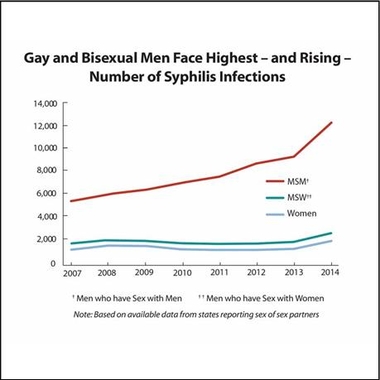On the rise

by Dustin Woods
Contributing Writer
When getting my regular HIV test at Expressions Community Center, I was also tested for syphilis. This is something that I hadn't been tested for at Expressions the last few times I went.
Curious about the impacts that syphilis has on our community and an individual’s body, I decided to take on writing about the topic. Admittedly before this experience the extent of my knowledge of syphilis came from medical dramas on television.
The Centers for Disease Control (CDC) website explains that syphilis is a bacteria that is spread through sores known as chancres. These chancres can occur in the vagina, anus, rectum, exterior genitals and even the mouth.
During the first phase of syphilis these sores may be the only visible sign you have been infected and because they occur in areas that one may not find it easy to see, they are not easily found. The average time between infection and the presentation of first symptoms is 21 days but can vary from 10 to 90 days.
The second phase of the infection comes with a rash that may manifest on the soles of the feet or the palms of the hands and sometimes the rash presents itself all over the body especially the torso. Given enough time these rashes will go away, but without treatment the syphilis will stay in the body and can lead to late stage symptoms. Up to 10-20 years later, when left untreated, syphilis can cause damage to internal organs.
If that isn't unsettling enough, there are other impacts of syphilis that influence one’s brain called neurosyphilis. This is where the infection invades the nervous system which can lead to symptoms ranging from headaches to altered behavior to Parkinson’s-like movement problems.
Among the most striking things to learn from the CDC about syphilis is the rate at which it is spreading through the LGBTQ community. In 2015, 81.7 percent of all syphilis cases that the gender of the sex partner was known were among men who have sex with men. The gay community needs to realize that we are the ones with the highest level of risk and we can absolutely do something about that. Regular testing for those at risk of contracting syphilis should go without saying, except the rates say otherwise.
There were nearly twice as many reported new cases of syphilis than HIV. HIV gets a lot of attention and rightly so. HIV can't be cured yet and syphilis can. But if syphilis can be cured, then in theory if we cured everyone who has it we should be able to eradicate it.
According to the Oklahoma State Health Department there were 209 new cases of syphilis reported in 2015. Seems like a small number when you consider the U.S. Census Bureau estimate of the population of Oklahoma in 2015 was around 3.9 million people.
I report the number to highlight the fact that the 2015 value is 77.1 percent higher than that of 2013. The problem has only increased with eighty new cases being reported in the past few months by the state Health Department.
However, it's still entirely possible for us to reduce the number of new cases.
In Oklahoma City, great organizations like the Latino Community Development Agency and Red Rock, in partnership with Expressions Community Center are doing what they can help that goal. By providing free testing they bring knowledge to those at risk, by giving out condoms and providing education they do what they can to promote sexual health.
Testing is available throughout The Gayly region. Check your local health department or any STI testing site.
If you haven't been tested for syphilis, or you haven't been tested in a while and you are at risk for catching a sexually transmitted disease, then go get tested. There are plenty of places to get tested for HIV and syphilis - just don't forget while you are there to get some free condoms.
Copyright 2017 The Gayly – March 29, 2017 @ 10:45 a.m.





